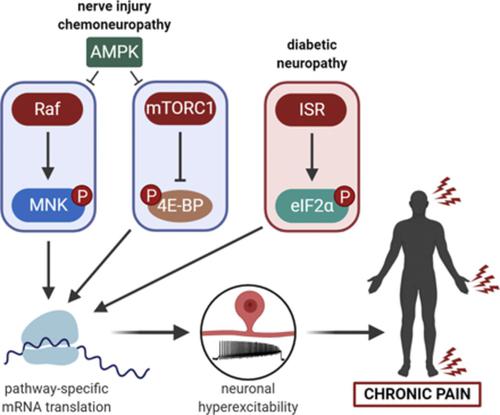当前位置:
X-MOL 学术
›
Pharmacol. Rev.
›
论文详情
Our official English website, www.x-mol.net, welcomes your
feedback! (Note: you will need to create a separate account there.)
Pharmacological Manipulation of Translation as a Therapeutic Target for Chronic Pain
Pharmacological Reviews ( IF 19.3 ) Pub Date : 2021-01-01 , DOI: 10.1124/pharmrev.120.000030 Muhammad Saad Yousuf 1 , Stephanie I Shiers 1 , James J Sahn 1 , Theodore J Price 2
Pharmacological Reviews ( IF 19.3 ) Pub Date : 2021-01-01 , DOI: 10.1124/pharmrev.120.000030 Muhammad Saad Yousuf 1 , Stephanie I Shiers 1 , James J Sahn 1 , Theodore J Price 2
Affiliation

|
Dysfunction in regulation of mRNA translation is an increasingly recognized characteristic of many diseases and disorders, including cancer, diabetes, autoimmunity, neurodegeneration, and chronic pain. Approximately 50 million adults in the United States experience chronic pain. This economic burden is greater than annual costs associated with heart disease, cancer, and diabetes combined. Treatment options for chronic pain are inadequately efficacious and riddled with adverse side effects. There is thus an urgent unmet need for novel approaches to treating chronic pain. Sensitization of neurons along the nociceptive pathway causes chronic pain states driving symptoms that include spontaneous pain and mechanical and thermal hypersensitivity. More than a decade of preclinical research demonstrates that translational mechanisms regulate the changes in gene expression that are required for ongoing sensitization of nociceptive sensory neurons. This review will describe how key translation regulation signaling pathways, including the integrated stress response, mammalian target of rapamycin, AMP-activated protein kinase (AMPK), and mitogen-activated protein kinase–interacting kinases, impact the translation of different subsets of mRNAs. We then place these mechanisms of translation regulation in the context of chronic pain states, evaluate currently available therapies, and examine the potential for developing novel drugs. Considering the large body of evidence now published in this area, we propose that pharmacologically manipulating specific aspects of the translational machinery may reverse key neuronal phenotypic changes causing different chronic pain conditions. Therapeutics targeting these pathways could eventually be first-line drugs used to treat chronic pain disorders.
中文翻译:

翻译的药理学操作作为慢性疼痛的治疗靶点
mRNA 翻译调节功能障碍日益成为许多疾病和病症的特征,包括癌症、糖尿病、自身免疫、神经退行性变和慢性疼痛。美国大约有 5000 万成年人患有慢性疼痛。这种经济负担比心脏病、癌症和糖尿病相关的每年费用加起来还要大。慢性疼痛的治疗方案不够有效,并且充满不良副作用。因此,对于治疗慢性疼痛的新方法存在着未满足的迫切需求。沿着伤害感受通路的神经元的敏感性会导致慢性疼痛状态,从而引发包括自发性疼痛以及机械和热过敏等症状。十多年的临床前研究表明,翻译机制调节基因表达的变化,这是伤害性感觉神经元持续敏化所需的。这篇综述将描述关键的翻译调控信号通路,包括整合应激反应、雷帕霉素的哺乳动物靶标、AMP 激活蛋白激酶 (AMPK) 和丝裂原激活蛋白激酶相互作用激酶,如何影响不同 mRNA 子集的翻译。然后,我们将这些翻译调节机制置于慢性疼痛状态的背景下,评估当前可用的疗法,并检查开发新药物的潜力。考虑到该领域目前发表的大量证据,我们提出,通过药理学操纵转化机制的特定方面可能会逆转导致不同慢性疼痛状况的关键神经元表型变化。 针对这些途径的治疗最终可能成为用于治疗慢性疼痛疾病的一线药物。
更新日期:2020-11-18
中文翻译:

翻译的药理学操作作为慢性疼痛的治疗靶点
mRNA 翻译调节功能障碍日益成为许多疾病和病症的特征,包括癌症、糖尿病、自身免疫、神经退行性变和慢性疼痛。美国大约有 5000 万成年人患有慢性疼痛。这种经济负担比心脏病、癌症和糖尿病相关的每年费用加起来还要大。慢性疼痛的治疗方案不够有效,并且充满不良副作用。因此,对于治疗慢性疼痛的新方法存在着未满足的迫切需求。沿着伤害感受通路的神经元的敏感性会导致慢性疼痛状态,从而引发包括自发性疼痛以及机械和热过敏等症状。十多年的临床前研究表明,翻译机制调节基因表达的变化,这是伤害性感觉神经元持续敏化所需的。这篇综述将描述关键的翻译调控信号通路,包括整合应激反应、雷帕霉素的哺乳动物靶标、AMP 激活蛋白激酶 (AMPK) 和丝裂原激活蛋白激酶相互作用激酶,如何影响不同 mRNA 子集的翻译。然后,我们将这些翻译调节机制置于慢性疼痛状态的背景下,评估当前可用的疗法,并检查开发新药物的潜力。考虑到该领域目前发表的大量证据,我们提出,通过药理学操纵转化机制的特定方面可能会逆转导致不同慢性疼痛状况的关键神经元表型变化。 针对这些途径的治疗最终可能成为用于治疗慢性疼痛疾病的一线药物。











































 京公网安备 11010802027423号
京公网安备 11010802027423号